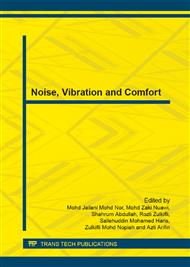p.241
p.247
p.255
p.261
p.267
p.273
p.279
p.285
p.293
Passive Damping Treatment on Aircraft's Non-Flush Patch Repair Scheme
Abstract:
The majority of aircrafts structure cracks due to fatigue are thin gage metallic structures and secondary support structures. Beside lower fatigue strength, they may also occur due to mechanical defects, especially at weak area and for areas exposed to high repetitive force such as vibration, friction, acoustic load and tensile force. Normally, the Original Equipment Manufacturer (OEM) recommended the aircraft operator to repair the crack by typical patch or doublers repair technique which is formally known as Non-Flush Patch Repair Scheme. However, the crack tends to reappear and tend to be more severe. The natural frequency and damping ratio of a structure which is treated with Typical Non-Flush Patch Repair, with and without Passive Damping Treatment (PDT) are studied using impulse based technique. Experimental data are presented to demonstrate the difference of damping ratio (ζ) among the test specimens. The cracked structure which has been treated with PDT on Non-Flush Repair Scheme has a better damping ratio and resonates at a different natural frequency. The experiment data generated from this study can be used as a basis to further the study on aircrafts structural repair scheme.
Info:
Periodical:
Pages:
267-272
Citation:
Online since:
December 2013
Price:
Сopyright:
© 2014 Trans Tech Publications Ltd. All Rights Reserved
Share:
Citation:


